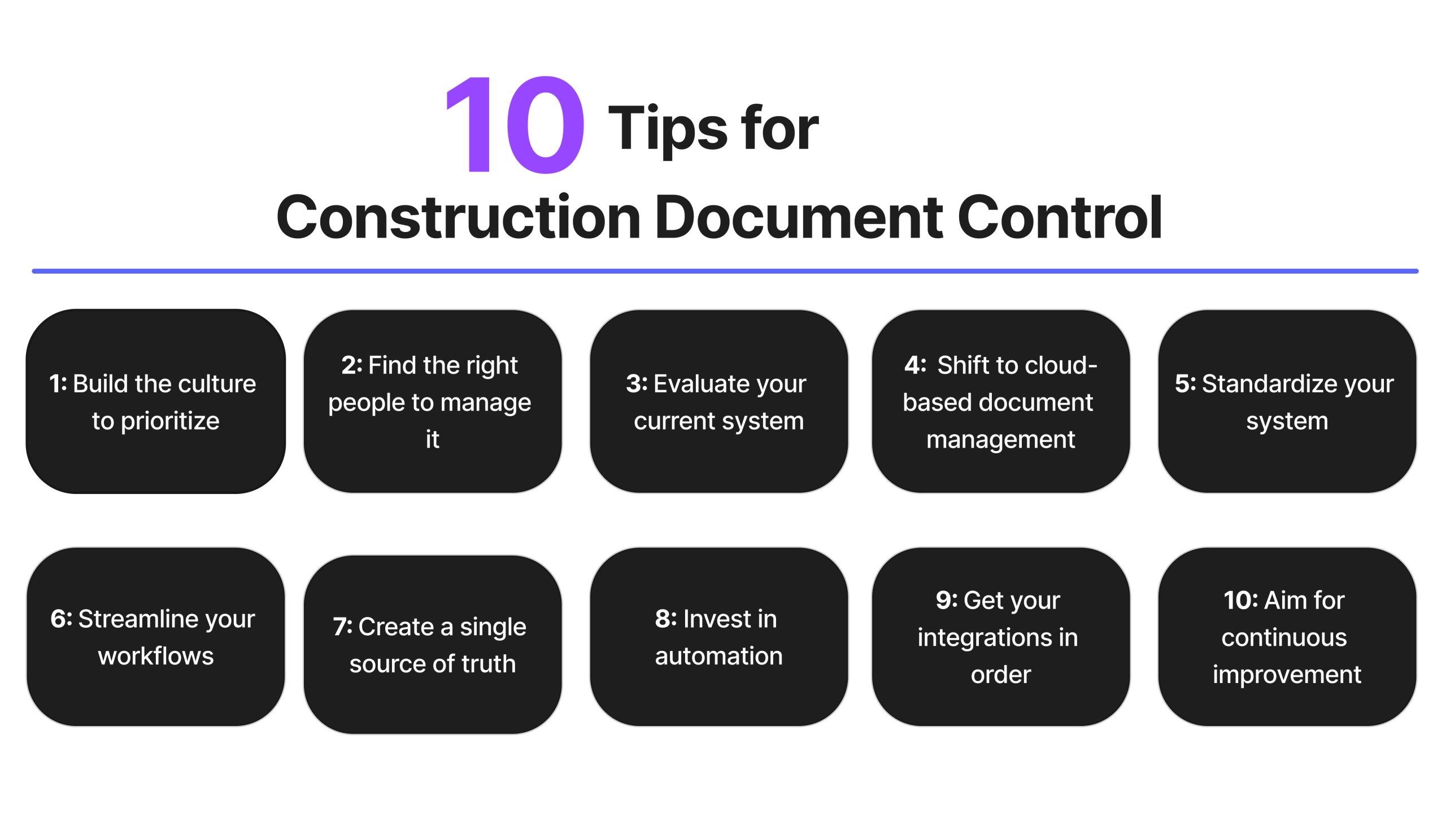
Have you ever searched for something you knew existed but were unable to find? A seemingly hidden shoe or book, only to reveal itself when the moment passes (and usually right next to the spot you first looked). Unfortunately, this disorder is a part of life. In construction, this chaos seems to be the norm, especially when it comes to documents. With records split between paper and digital, office and field, stakeholders and workers, it’s no wonder there exists so much error and rework.
However, no one would choose this chaos. But as more teams are added to a project, jobs get more complicated and people just get busier, organization tends to fall by the wayside. As a result, a shocking number of companies in the building industry have poor construction document control. Moreover, this explains why 35% of construction professionals’ time is spent hunting down project information–representing a decline in productivity.
So what’s the answer to solve this common but insanely costly construction challenge?
While the solution is simple, it might not be necessarily easy: good construction document control. Before you can put that into place, however, it’s essential to understand the fundamentals.
Construction documents refers to the plans, specifications, change orders, revisions, and other relevant information which set forth in detail the scope of work to be performed for a construction project.
In our blog, we’ll define what it means to have a grip on construction document control and 10 practices that are essential to success.
So what does it mean to have your construction documents under control? Good question.
According to Consepsys, its purpose “is to enforce controlled processes and practices for the creation, review, modification, issuance, distribution and accessibility of documents.” Moreover, good document control “ensures that documentation available at official points of use within an organization is trusted by its users and contains up-to-date, reliable, checked and formally approved information.”
This means documents and information should fit the following criteria:
Considering how often buildings get updated during design, construction and operations, it’s no surprise that document control is both difficult to maintain and critical to implement.
When construction document management is not practiced diligently by teams, the results of the disorganization are pretty dire. In addition to the above statistics, here are some of the other downsides:
When staff looks for information that’s not easy to track down, they’re not spending that time on activities that actually lead to the company’s bottom line. According to FMI and Autodesk report, construction professionals waste on average 5.5 hours a week looking for project plans and information. That’s more than a third of the 14% of non-optimal activities spent on re-finding and re-reading information that’s already been disseminated.
Such activities essentially represent rework, not physical but rather mental. That’s before the emotional toll this takes, which tends to erode productivity even further. Then there’s the actual rework.
Poor construction document control leads to a lot of version confusion, in which teams work from wrong sets of information and trades aren’t coordinated. When this happens, errors occur and work has to be redone. That results in a massive headache for everyone involved, not to mention it decimates the predicted timeline and budget of the entire project.
Fixing errors represents a considerable amount of wasted resources. That means more materials and more labor, which in turn represents more budget, more time and dreaded overruns. Needless to say, this makes people pretty unhappy, which frequently leads to...
When documentation isn’t thorough, and an error occurs, litigation can arise with lengthy disputes. Construction is one of the most ferocious fields when it comes to legal disputes. Note that lawsuits can cost you more than money, too. They can also erode your reputation, dissuade clients from working with you, cut into your workflow and even end projects midway. This kind of lost time, money and public standing can ruin a company.
The good news? It doesn’t have to be that way. Taking the steps necessary to practice good document control can lead to a huge number of benefits, including:

While construction document control might feel daunting at first, it’s a relatively simple process of implementing new approaches to old systems. Want to learn more about construction document control and how you can achieve it in your company? Let’s take a look at the 10 best ways to implement systems that work now and in the future so you can maintain that good reputation for which you’ve become known.
It’s impossible to implement new systems if you don’t first get your staff on board about the importance of quality construction document control. This makes the difference between getting home early some days and staying late on the site again and again. It makes the difference between completing a project on time and running way over. In other words, it’s all the difference.
At first, you might meet resistance from older-school staff who have been doing their jobs the same way for 20 years. When that happens, make an effort to guide these staff on the benefits and make sure you listen to their feedback, as they will be likely your power users at the end of the day. This might involve a bit of custom training when it comes time to update a system or get a completely new one, but it’s worth it.
Make sure there is a similar level of buy-in from executive staff, as they will likely be the ones that can help you get a new system or process over the hill.
As part of a culture shift to proper construction document control, it’s vital that every employee feels empowered to be responsible for the success of document management. But while everyone on your team should be participating in making document control a success, having a key contact to make any changes and oversight is vital.
This contact can troubleshoot potential issues, establish templates and keep workflows moving. They can also identify staff who are not following new procedures and help get them back on track. Lastly, they should be experts in the system you are using, so they can be an internal point of reference if needed.
If you think your system for construction document control is robust, ask yourself the following questions:
If you can’t say “yes” to all of the above questions, it’s time to evaluate your construction document management and put a better system in place.
First things first: Get rid of paper. We repeat: Get rid of paper. It’s nearly impossible to practice good construction document control with loose leaves and sheaves of printer paper, blueprints and memos floating around.
Other culprits of document disorganization include systems like Excel and a heavy reliance on email. Disjointed email chains are not helpful for document management, with attachments that are hard to track down and hardly ever the right version. Dependence on email, in fact, is probably doing a number on your productivity. Same story with Excel. Going digital with the right cloud-based system is the only way to achieve construction document management.
It’s crucial that you have one construction document control system to centralize your documents. When evaluating software options, ask yourself if it fits the criteria above. If you’re even a little bit uncertain, don’t do it.
Once you have the right system that fits the criteria, try to achieve standardization. This might be a slower process than anticipated as you gain buy-in, but it's well worth it over time to have your entire project and company working from the same system with the same templates–no exceptions.
A streamlined and standardized workflow is critical to construction document control. Establish what works best for your company and projects in terms of workflows through first asking questions such as:
There’s no right answer for one company; it depends entirely on your current structure and even can look different on a project to project basis. While workflows should be structured and controlled, it’s also important to keep some flexibility, which allows you to address changes and issues efficiently, should they occur. Once you have a system, stick to it, training people where necessary.
Creating a single source of truth is both imperative to and the most significant benefit of construction document control. This means that if staff needs the most current set of documents, they can feel rest assured that when they search for it in your system, that’s exactly what they’re finding. Everyone can see the changes and know precisely what those changes encompassed. Access to historical docs is still available, but it’s clear what’s new and what’s old.
For document control to work, you not only need all the information, but you also need the correct information. While it may feel safer to enter things manually, this opens up documents and plans for errors. Look for advanced solutions that can automate things for you, whether it’s a simple solution to organize existing documents or a complicated process like turning a specification book into submittals in minutes.
Automation reduces the admin burden of document control while making things more accurate, so wherever possible, put it to use for you.
Likely you are using multiple solutions for documents and data in construction. That’s completely okay, given that some systems serve only one niche, but are nevertheless critical to the overall process. The solution isn’t to remove specialized systems, but to make sure they can talk to one another.
Again, this goes back to establishing your single source of truth. After all, if docs are in multiple places, someone will likely work off the wrong thing and changes won’t be reflected elsewhere. This could create mass amounts of rework and errors due to data and information silos.
The answer, of course, is construction document control that enables communication between existing software systems. Think carefully about the systems you have and where integrations can be made. Solutions exist to make software connections easier and to help centralize project data and documents.
Setting up a system for construction document control isn’t a one and done kind of thing. It needs to be nurtured and evolved over time based on your company and people. Your goal should be a continuous improvement rather than a perfect solution upfront. Do a periodic assessment of how things are going with your current document control system.
Make sure you speak to all your staff, especially field staff, about how it’s going and what they would suggest for improvement. That way, you’ll not only earn buy-in, but you’ll also keep it forever.
Again, while the above strategies are easy enough to maintain once instituted, it’s essential to take them slowly at first. Otherwise, you risk confusion, burnout and rebellion from managers and workers who feel overwhelmed by all the new changes. Before you put these strategies into effect, meet with stakeholders and discuss them, then let them know what’s coming. This will ease the transition for everyone and ensure a fantastic construction document control system for life.
